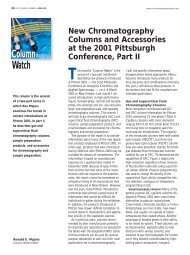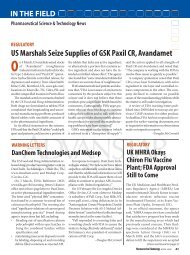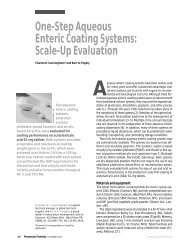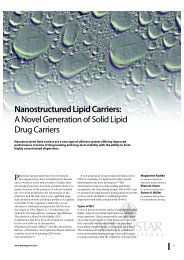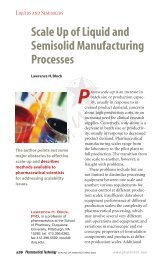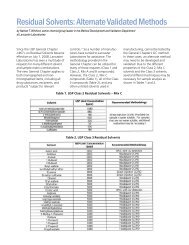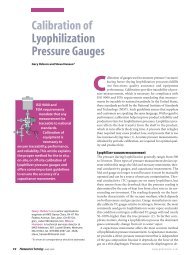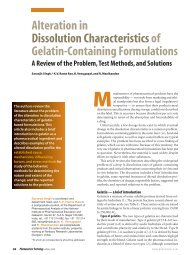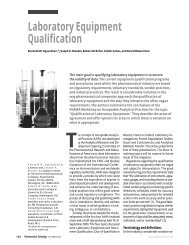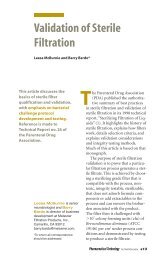Autosamplers - Chromatography Online
Autosamplers - Chromatography Online
Autosamplers - Chromatography Online
Create successful ePaper yourself
Turn your PDF publications into a flip-book with our unique Google optimized e-Paper software.
www.chromatographyonline.com<br />
previous generation of autosamplers suffered<br />
from balky mechanical designs and a<br />
lack of electrical–mechanical and software<br />
integration, which made them much less<br />
reliable and much less flexible than more<br />
recent designs. Today’s autosamplers,<br />
though, are dedicated robots with even<br />
more complex and precise mechanisms<br />
than earlier designers could access. They<br />
also present more possibilities for failure,<br />
but the chances of any one component<br />
failing are radically less than in earlier<br />
designs. The overall probability of failure is<br />
reduced considerably.<br />
When a modern autosampler does experience<br />
an electrical or mechanical problem,<br />
the autosampler’s software and sensors very<br />
likely will sense the problem, gracefully<br />
pause or halt the analysis sequence, and<br />
alert an operator. A simple example is a<br />
missing solvent vial. In this case, most<br />
autosampling systems will present a message<br />
to that effect and then wait for an<br />
operator to correct the condition and signal<br />
back to the autosampling system that it<br />
should continue. A more extreme example<br />
would involve a broken drive belt, and in<br />
that case the autosampler sensors would<br />
detect the failure of parts to move into<br />
position on command. The controlling<br />
software would then stop attempting to<br />
move the failed component, signal that a<br />
serious failure has occurred, and halt the<br />
analysis sequence until an operator restarts<br />
it. At this point, it’s often a good idea to<br />
run the autosampler diagnostics to try to<br />
pinpoint the problem. Make a written<br />
record of the diagnostic results for future<br />
reference.<br />
Serious failures of this type may require<br />
a trained service person for the repair. In<br />
particular, the installation and alignment of<br />
newly installed components is critical.<br />
Most chromatographers find it fairly easy<br />
to disassemble an autosampler and remove<br />
a broken part, but they usually don’t have<br />
the tools and information required to put<br />
it back together. <strong>Autosamplers</strong>’ high speeds<br />
and precise motions require tight tolerances<br />
and precision alignment. As I have<br />
often said, bringing in a trained professional<br />
who can repair an instrument<br />
quickly and get it running is well worth<br />
the extra outlay in the long run.<br />
Chromatographic Problems<br />
Another class of autosampler problems<br />
arises when the autosampling system<br />
appears to function normally, but the chromatographic<br />
results are not as good as<br />
expected. In these cases, chromatographers<br />
can use a process of elimination to help<br />
isolate the problem at the autosampler, the<br />
inlet, or the column and identify what<br />
remedial action might be appropriate.<br />
The autosampler is the first link in the<br />
separation and detection chain, and poor<br />
injection is reflected all the way to the<br />
data-handling system. The simplest<br />
method for locating a problem that might<br />
be autosampler-related is to remove it as a<br />
potential problem source by making several<br />
manual injections. Those manual injections<br />
will help determine if the autosampler<br />
is at fault. Although manual injections<br />
will not reproduce the exact injection conditions<br />
that an autosampler would deliver,<br />
serious autosampler problems often will<br />
disappear or moderate with manual injection.<br />
In most cases, it is appropriate to<br />
establish a test mixture that includes the<br />
target analytes or their analogues at known<br />
concentrations that lie well within the<br />
capability of the chromatographic system.<br />
If trace analysis is the objective, then use a<br />
standard mix with concentrations that are<br />
20–50 times greater than the method<br />
detection limit for the system in use. With<br />
splitless injection and a flame ionization<br />
detector, this amount might signify concentrations<br />
in the 10–1000 ppb range. For<br />
50–100 L large-volume injections, the<br />
concentrations might be somewhat lower.<br />
Record test chromatograms when the system<br />
is functioning well to establish a<br />
checkpoint for later verification. Verification<br />
may include more system-suitability<br />
tests for separation, resolution, and reproducibility<br />
(see below).<br />
If manual injections produce similar<br />
problems to those of the autosampling<br />
injections, then look at the inlet system<br />
next and check for correct inlet installation,<br />
flow rates, and valve timing. If manual<br />
injection provides better results than<br />
autosampling, then examine the autosampler<br />
and its program settings. For normal<br />
autosampling, try varying autosampler<br />
parameters such as injection speed, injection<br />
volume, and the number of pre- and<br />
postinjection washes to see if these settings<br />
make any difference. Check to be sure that<br />
the selected program parameters are appropriate<br />
for the injection technique. Be alert<br />
for suspicious noises during sampling and<br />
visually check the autosampler, syringe,<br />
vials, robot arm, and any other active components<br />
as they operate.<br />
Determining Repeatability<br />
One reason that analysts use autosamplers<br />
is to obtain better results repeatability than<br />
manual injections will yield. Chromatographers<br />
have certain expectations for repro-<br />
DECEMBER 2000 LCGC VOLUME 18 NUMBER 12 1239<br />
VICI Gig Harbor<br />
1/3 Page Vert Ad<br />
Circle 32



